NEON support in the RealView compiler
William Munns
18 June 2007
Introduction
This paper provides a simple introduction to the NEONTM Vector-SIMD architecture. It
continues by looking at the compiler support for SIMD, both through automatic recognition
and through the use of intrinsic functions.
NEON is a hybrid 64/128 bit SIMD architecture extension to the ARM v7-A profile,
targeted at multimedia applications. Positioning NEON within the processor allows it to
share the CPU resources for integer operation, loop control, and caching, significantly
reducing the area and power cost compared with a CPU plus hardware accelerator
combination. SIMD (Single Instruction Multiple Data) is where one instruction acts on
multiple data items, usually carrying out the same operation for all data.
The use of NEON instead of a CPU plus hardware accelerator combination allows savings
to be made in software development time as it creates a much simpler programming model
without forcing the programmer to search for ad-hoc concurrency and scheduling points.
On the ARM Cortex™-A8 the NEON unit is positioned in the pipeline so that loads can
come directly from the L2 cache. This means that a much larger dataset can be held in the
cache than would be allowed when executing ARM or Thumb®-2 code.
The NEON instruction set was designed to be an easy target for a compiler, including low
cost promotion/demotion and structure loads capable of accessing data from their natural
locations rather than forcing alignment to the vector size.
The RealView Development Tools® Suite version 3.1 supports NEON both in the standard
release using intrinsic functions and assembler, as well as through the vectorizing compiler
add-on which can recognise code sequences and automatically generate SIMD code. The
vectorizing compiler greatly reduces porting time, as well as reducing the requirement for
deep architectural knowledge.
© 2007 ARM Limited. All Rights Reserved.
ARM and RealView logo are registered
trademarks of ARM Ltd. All other trademarks
are the property of their respective owners and
are acknowledged
- 1 -
�
Overview of NEON Vector SIMD
SIMD is the name of the process for operating on multiple data items in parallel using the
same instruction. In the NEON extension, the data is organized into very long registers (64
or 128 bits wide). These registers can hold "vectors" of items which are 8, 16, 32 or 64 bits.
The traditional advice when optimizing or porting algorithms written in C/C++ is to use the
128 bit Q register
4 x 32 bit Data
8 x 16 bit Data
16 x 8 bit Data
natural type of the machine for data handling (in the case of ARM 32 bits). The unwanted
bits can then be discarded by casting and/or shifting before storing to memory. The ability
of NEON to specify the data width in the instruction and hence use the whole register
width for useful information means keeping the natural type for the algorithm is both
possible and preferable. Keeping with the algorithms natural type reduces the cost of
porting an algorithm from one architecture to another and allows more data items to be
simultaneously operated on.
NEON appears to the programmer to have two banks of registers, 64 bit D registers and
128 bit Q registers. In reality the D and Q registers alias each other, so the 64 bit registers
D0 and D1 map against the same physical bits as the register Q0.
When an operation is performed on the registers the instruction specifies the layout of the
data contained in the source and, in certain cases, destination registers.
- 2 -
�
Example: Add together the 16 bit integers stored in the 64 bit vector D2 and 64 bit vector
D1 storing the resultant items in the 64 bit register D0
VADD.I16 D0, D1, D2
This instruction will cause four 16 bit adds
+
+
+
+
D1
D2
D0
Promotion/demotion of types
Promotion/demotion of types is a very common operation in C. Casting to larger types can
be used to avoid overflow or increase precision. Shifting into smaller types allows
compatibility at interfaces or reduced memory usage. In contrast with some other SIMD
architectures, NEON provides compound operations which combine type promotion with
arithmetic operations. This allows NEON code to make better use of the register file and
use fewer instructions.
Example: Multiply together the 16 bit integers stored in the 64 bit vectors D2 and D3
storing the resultant items in the 128 bit register Q0
VMUL.I32.S16 Q0, D2, D3
This instruction will cause four widening multiplies
*
*
*
*
D2
D3
Q0
Example: Shift right by #5 the four 32 bit integers stored in 128 bit vector Q1, truncate to
16 bits and store the resultant 16 bit integers in 64 bit register D0
VSHR.I16.I32 D0, Q1,#5
This instruction will cause four narrowing shifts
>>
>>
>>
>>
Q1
#
#5
D
D0
- 3 -
�
Structure load and store operations
Often items are not held in memory as simple arrays, but rather arrays of structures for
logically grouped data items.
For example it is common to find a screen represented as an array of structures of pixels
rather than split into three arrays of red, green and blue items. Storing all components of
pixel data together allows faster operation for common operations such as colour
conversion or display, however it can cause difficulties for some SIMD implementations.
struct rgb_pixel
{
short r; /* Red */
short g; /* Green */
short b; /* Blue */
}s[X_SIZE*Y_SIZE]; /* screen */
The NEON unit includes special structure load instructions which can load whole
structures and spilt them accordingly across multiple registers.
Example: Load 12 16 bit values from the address stored in R0, and split them over 64 bit
registers D0, D1 and D2. Update R0 to point at next structure.
VLD3.16 {D0,D1,D2}, [R0]!
Structure load and store better matches how engineers write code, so code usually does not
need to be rewritten to take advantage of it.
- 4 -
�
Writing NEON code using the standard RealView compiler
The standard tools shipped with RealView Development Suite 3.1 have support for NEON
directly in the assembler and embedded assembler. The compiler also provides NEON
support using pseudo functions called intrinsics. Intrinsic functions compile into one or
more NEON instructions which are inserted at the call site. There is at least one intrinsic
for each NEON instruction, with multiple intrinsic functions where needed for signed and
unsigned types.
Using intrinsics, rather than programming in assembly language directly, allows the
compiler to schedule registers, as well as giving the programmer easy access to C variables
and arrays.
Using vector registers directly from assembler could lead to programming errors such as a
64 bit vector containing data of 8 bits wide is operated upon by a 16 bit adder. These kind
of faults can be very difficult to track down as only particular corner cases will trigger an
erroneous condition. In the previous addition example, the output will only differ if one of
the data items overflows into another. Using intrinsics is type-safe and will not allow
accidental mixing of signed/unsigned or differing width data.
Accessing vector types from C
The header file arm_neon.h is required to use the intrinsics and defines C style types for
vector operations. The C types are written in the form :
uint8x16_t Unsigned integers, 8 bits, vector of 16 items - 128 bit “Q” register
int16x4_t
Signed integers, 16 bits, vector of four items - 64 bit "D" register
As there is a basic incompatibility between scalar (ARM) and vector (NEON) types it is
impossible to assign a scalar to a vector, even if they have the same bit length. Scalar
values and pointers can only be used with NEON instructions that use scalars directly.
Example: Extract an unsigned 32 bit integer from lane 0 of a NEON vector
result = vget_lane_u32(vec64a, 0)
Vector types are not operable using standard C operators except for assignment, so the
appropriate VADD should be used rather than the operator “+”.
Where there are vector types which differ only in number of elements (uint32x2_t,
uint32x4_t) there are specific instructions to ‘assign’ the top or bottom vector elements of a
128 bit value to a 64 bit value and vice-versa. This operation does not use any code space
as long as the registers can be scheduled as aliases.
Example: Use the bottom 64 bits of a 128 bit register
vec64 = vget_low_u32(vec128);
- 5 -
�
Access to NEON instructions using C
To the programmer intrinsics look like function calls. The function calls are specified to
describe the target NEON instruction as well as information about the source and
destination types.
Example: To add two vectors of 8 bytes, putting the result in a vector of 8 bytes requires
the instruction
VADD.I8 dx, dy, dz
Which can be provoked by using either of the following intrinsic functions
int8x8_t vadd_s8(int8x8_t a, int8x8_t b);
uint8x8_t vadd_u8(uint8x8_t a, uint8x8_t b);
The use of separate intrinsics for each type means that it is difficult to accidentally perform
an operation on incompatible types because the compiler will keep track of which types are
held in which registers. The compiler can also reschedule program flow and use alternative
faster instructions; there is no guarantee that the instructions that are generated will match
the instructions implied by the intrinsic. This is especially useful when moving from one
micro-architecture to another.
Programming using NEON intrinsics
The process of writing optimal NEON code directly in the assembler or by using the
intrinsic function interface requires a deep understanding of the data types used as well as
the NEON instructions available.
Possible SIMD operations become more obvious if you look at how an algorithm can be
split into parallel operations.
Commutative operations (add, min, max) are particularly easy from a SIMD point of view.
Example: Add 8 numbers from an array
unsigned int acc=0;
for (i=0; i<8;i+=1)
{
acc+=array[i]; // a + b + c + d + e + f + g + h
}
could be split into several adds ((a+e) + (b+f))+((c+g) + (d+h))
and recoded in C as:
Continued on next page…
- 6 -
�
unsigned int acc1=0;
unsigned int acc2=0;
unsigned int acc3=0;
unsigned int acc4=0;
for (i=0; i<8;i+=4)
{
acc1+=array[i]; // (a, e)
acc2+=array[i+1]; // (b, f)
acc3+=array[i+2]; // (c, g)
acc4+=array[i+3]; // (d, h)
}
acc1+=acc2; // (a+e) + (b+f)
acc3+=acc4; // (c+g) + (d+h)
acc1+=acc3; // ((a+e) + (b+f))+((c+g) + (d+h))
It should be more apparent now that we could use a vector register holding four 32 bit
values for the accumulator and temp registers then do the operation using SIMD
instructions. Now extending for any multiple of four:
#include
uint32_t vector_add_of_n(uint32_t* ptr, uint32_t items)
{
uint32_t result,* i;
uint32x2_t vec64a, vec64b;
uint32x4_t vec128 = vdupq_n_u32(0); // clear accumulators
for (i=ptr; i<(ptr+(items/4));i+=4)
{
uint32x4_t temp128 = vld1q_u32(i); // load 4x 32 bit values
vec128=vaddq_u32(vec128, temp128); // add 128 bit vectors
}
vec64a = vget_low_u32(vec128); // split 128 bit vector
vec64b = vget_high_u32(vec128); // into 2x 64 bit vectors
vec64a = vadd_u32 (vec64a, vec64b); // add 64 bit vectors together
result = vget_lane_u32(vec64a, 0); // extract lanes and
result += vget_lane_u32(vec64a, 1); // add together scalars
return result;
}
The vget_high_u32 and vget_low_u32 are not analogous to any NEON
instruction, but instruct the compiler to reference the Q register used to store vec128 as
two separate 64 bit D registers.
These operations therefore do not translate into actual code, but will have an effect on
which registers are used to store vec64a and vec64b.
- 7 -
�
Depending on the version of the compiler, target processor and optimization options, the
code generated becomes:
vector_add_of_n PROC
VMOV.I8 q0,#0
BIC r1,r1,#3
ADD r1,r1,r0
CMP r1,r0
BLS |L1.36|
|L1.20|
VLD1.32 {d2,d3},[r0]!
VADD.I32 q0,q0,q1
CMP r1,r0
BHI |L1.20|
|L1.36|
VADD.I32 d0,d0,d1
VMOV.32 r1,d0[1]
VMOV.32 r0,d0[0]
ADD r0,r0,r1
BX lr
ENDP
- 8 -
�


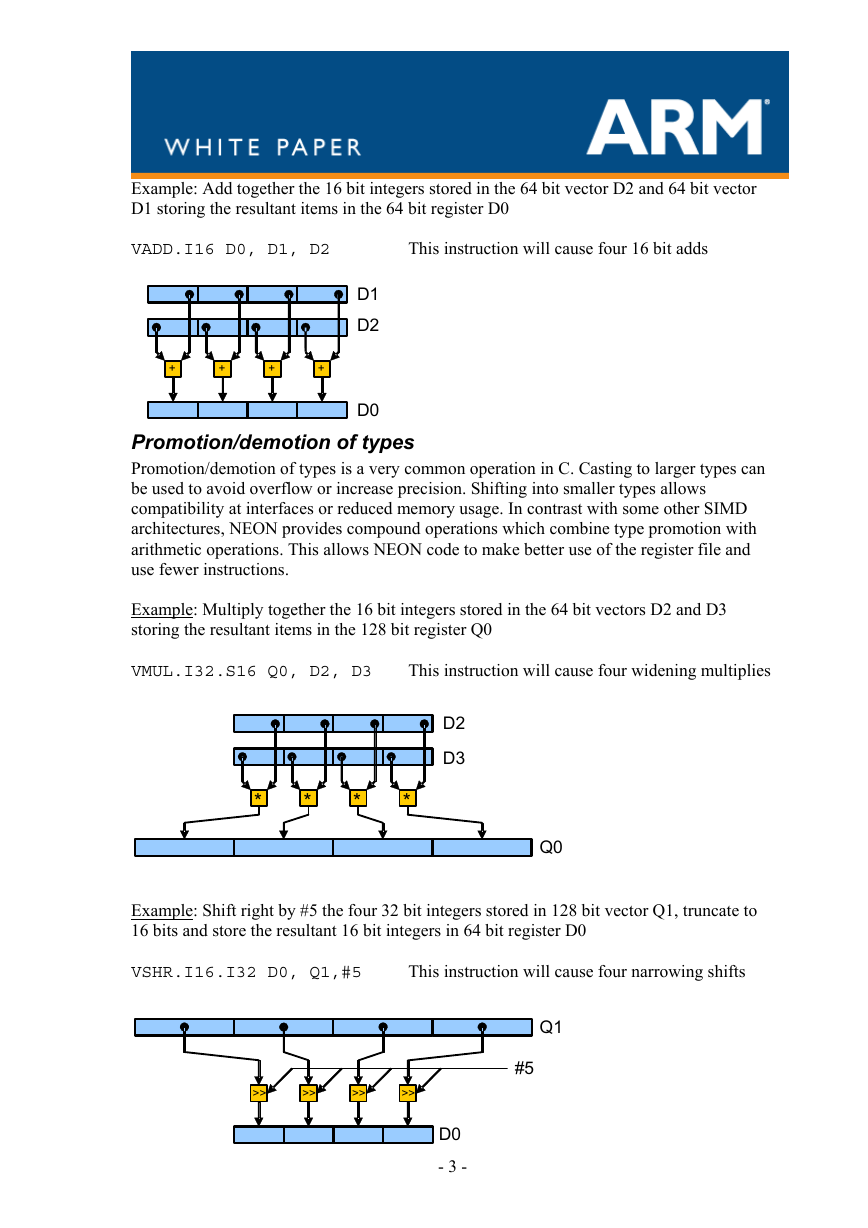
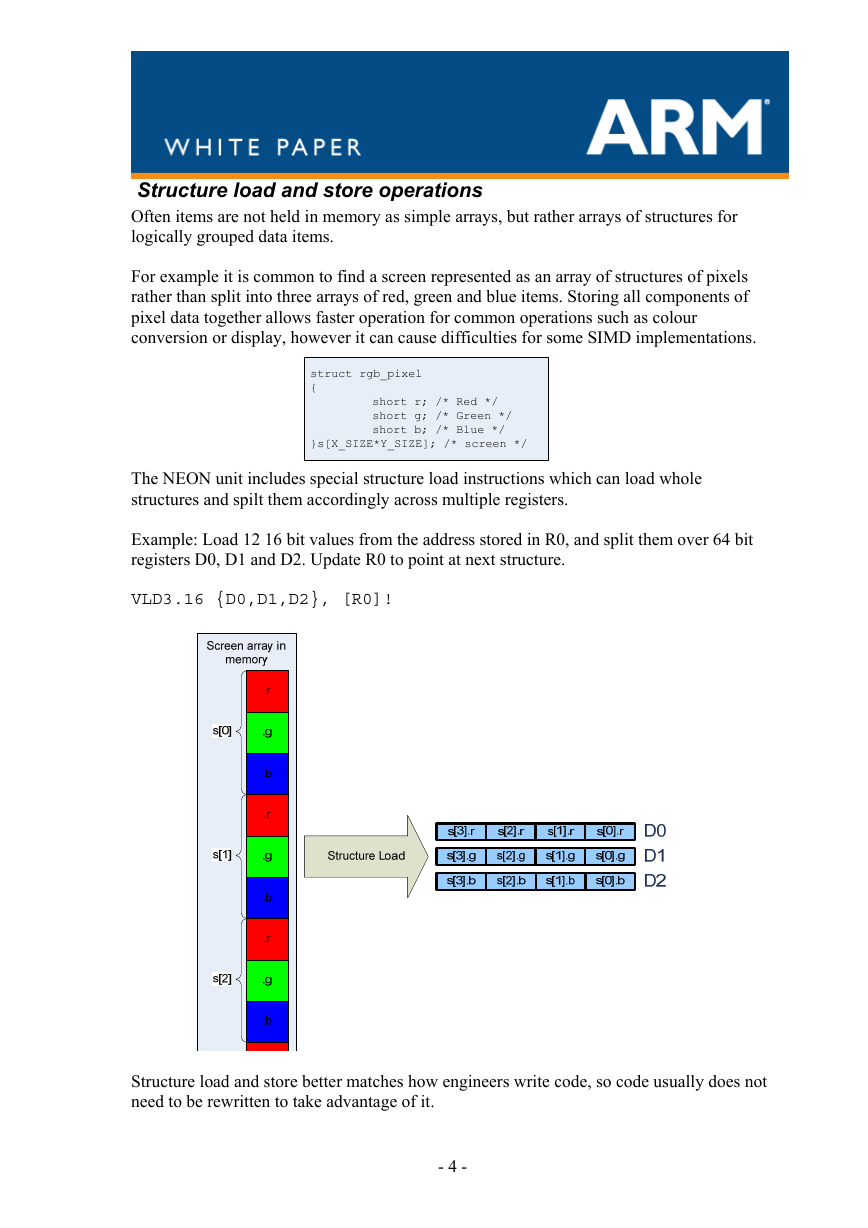
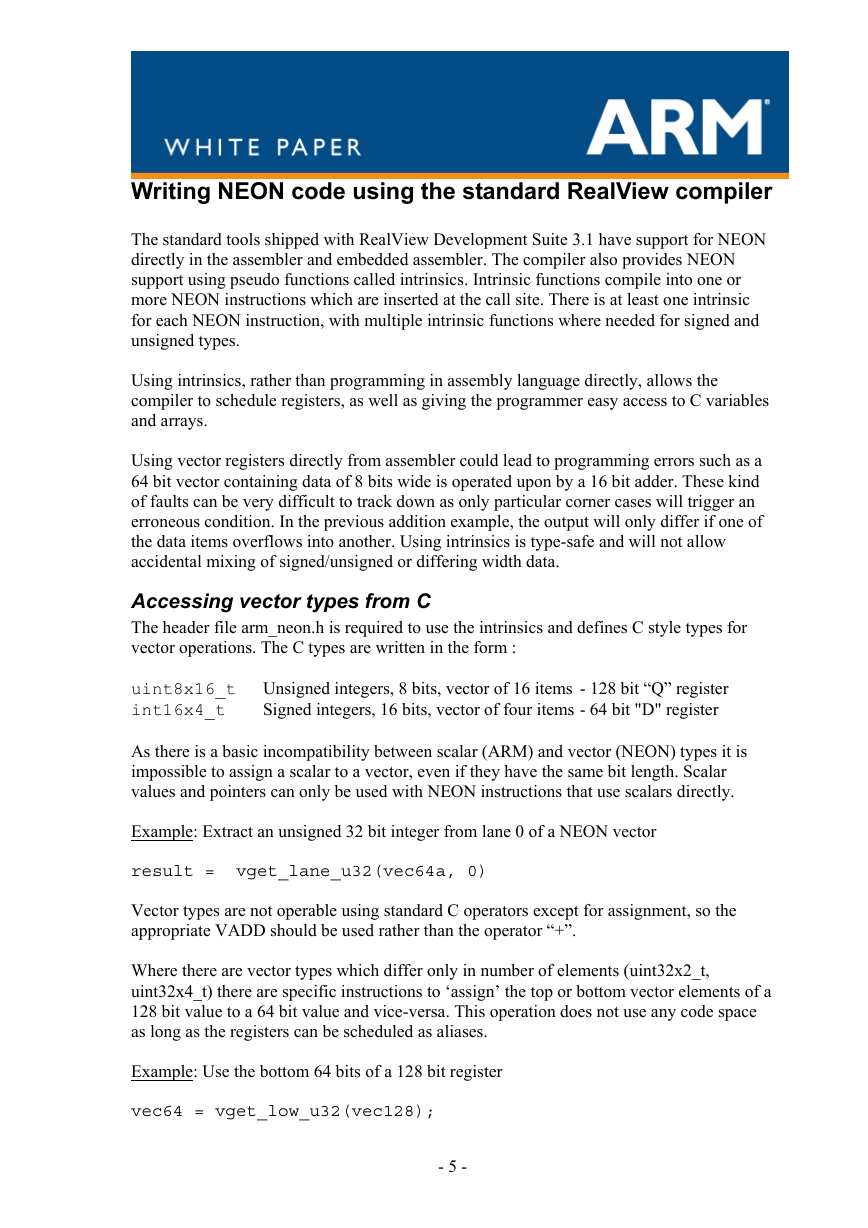
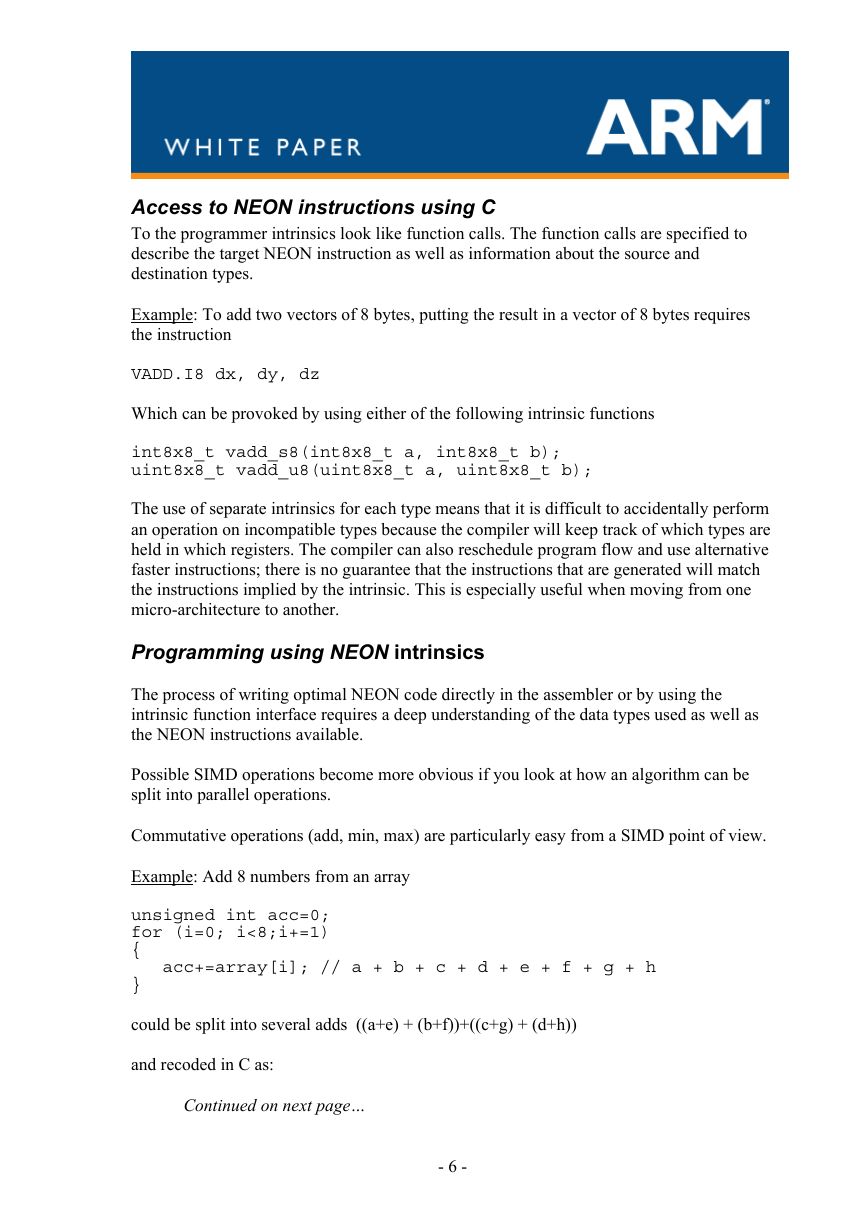
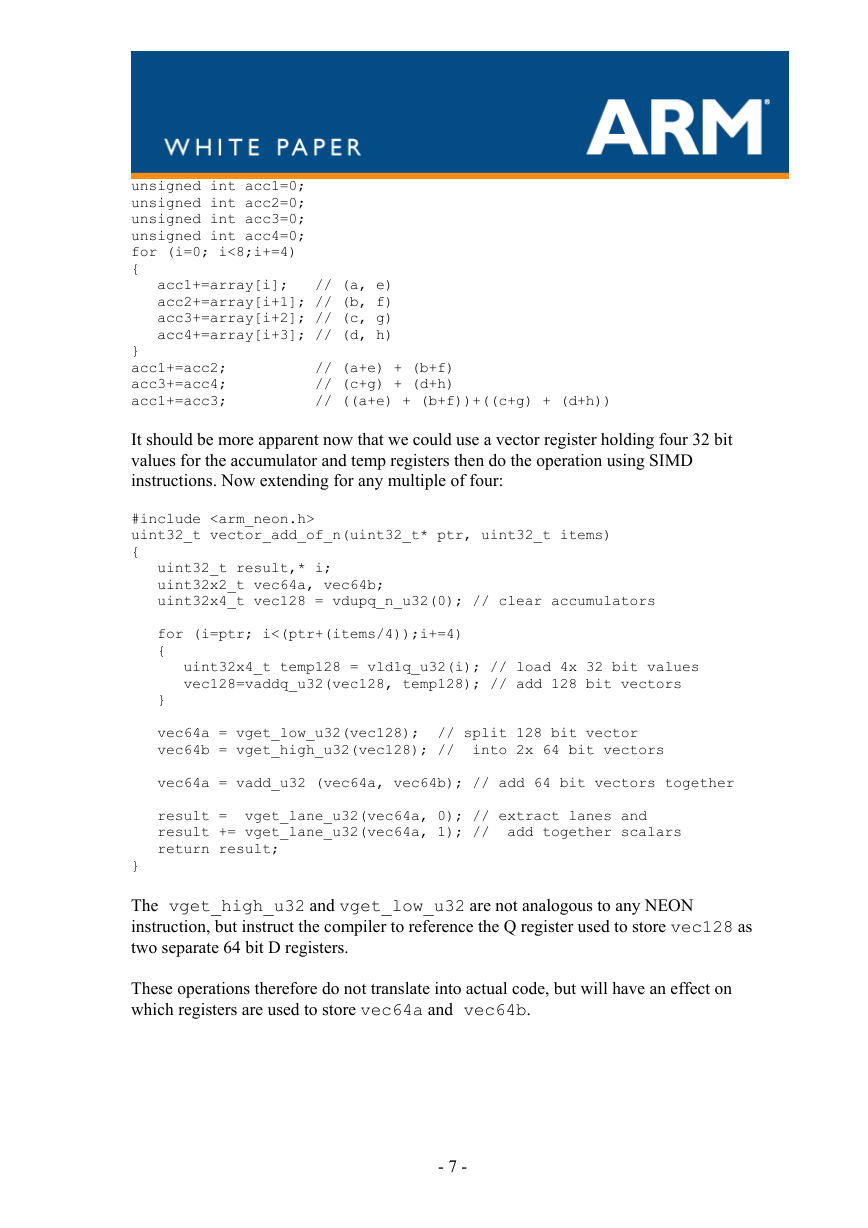
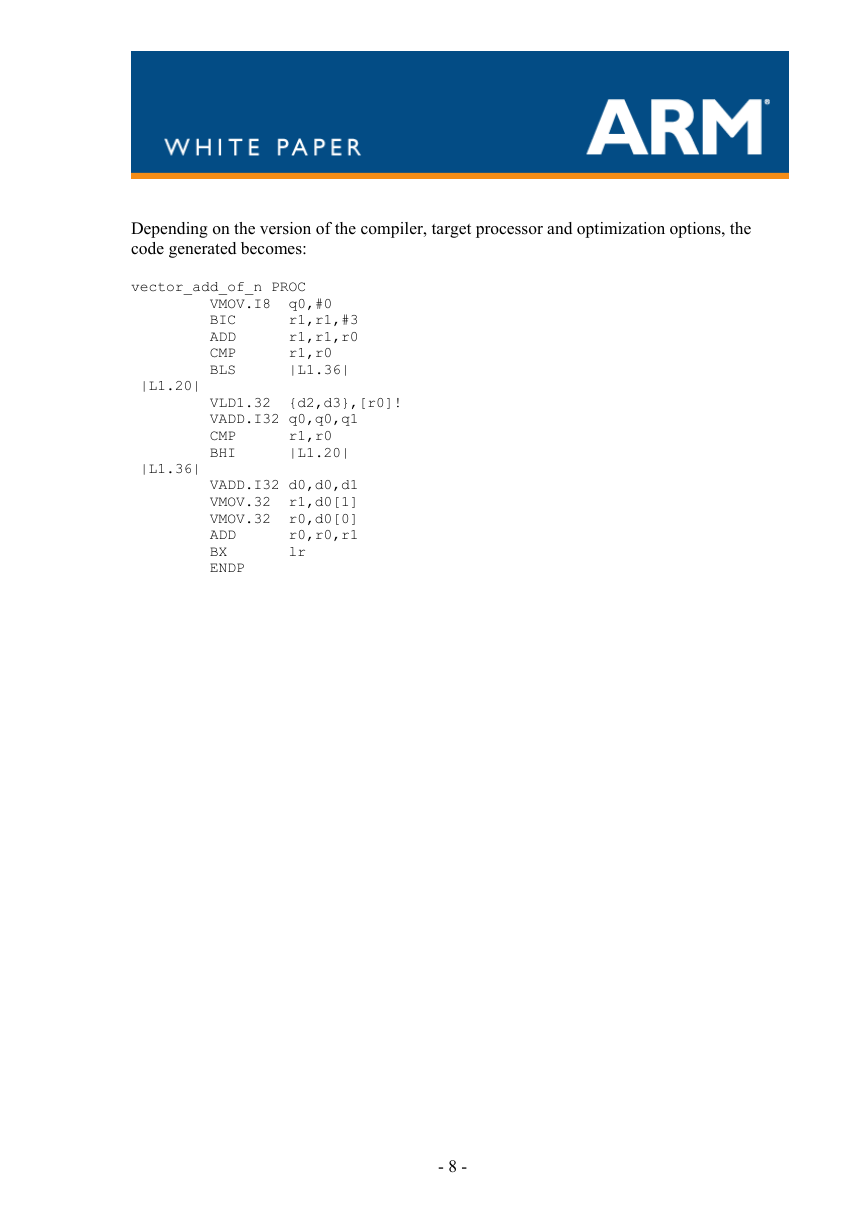








 2023年江西萍乡中考道德与法治真题及答案.doc
2023年江西萍乡中考道德与法治真题及答案.doc 2012年重庆南川中考生物真题及答案.doc
2012年重庆南川中考生物真题及答案.doc 2013年江西师范大学地理学综合及文艺理论基础考研真题.doc
2013年江西师范大学地理学综合及文艺理论基础考研真题.doc 2020年四川甘孜小升初语文真题及答案I卷.doc
2020年四川甘孜小升初语文真题及答案I卷.doc 2020年注册岩土工程师专业基础考试真题及答案.doc
2020年注册岩土工程师专业基础考试真题及答案.doc 2023-2024学年福建省厦门市九年级上学期数学月考试题及答案.doc
2023-2024学年福建省厦门市九年级上学期数学月考试题及答案.doc 2021-2022学年辽宁省沈阳市大东区九年级上学期语文期末试题及答案.doc
2021-2022学年辽宁省沈阳市大东区九年级上学期语文期末试题及答案.doc 2022-2023学年北京东城区初三第一学期物理期末试卷及答案.doc
2022-2023学年北京东城区初三第一学期物理期末试卷及答案.doc 2018上半年江西教师资格初中地理学科知识与教学能力真题及答案.doc
2018上半年江西教师资格初中地理学科知识与教学能力真题及答案.doc 2012年河北国家公务员申论考试真题及答案-省级.doc
2012年河北国家公务员申论考试真题及答案-省级.doc 2020-2021学年江苏省扬州市江都区邵樊片九年级上学期数学第一次质量检测试题及答案.doc
2020-2021学年江苏省扬州市江都区邵樊片九年级上学期数学第一次质量检测试题及答案.doc 2022下半年黑龙江教师资格证中学综合素质真题及答案.doc
2022下半年黑龙江教师资格证中学综合素质真题及答案.doc